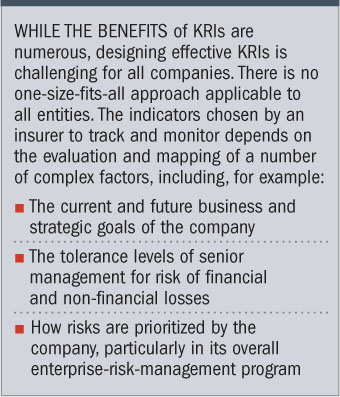Everyone wants to know what the future will bring—and this is especially true in the world of risk management, where professionals are dedicated to identifying current and future sources of risk or loss and eliminating or mitigating such potential loss through the application of controls.
 In this process, key risk indicators (KRIs) are metrics or pieces of data serving as early warning signs of areas of increasing risk. KRIs portend future trends, losses and opportunities. When managed efficiently, they can be used by risk managers to proactively monitor operational processes and identify potential business, legal, financial or other environmental risks that may affect the company—long before they can occur.
In this process, key risk indicators (KRIs) are metrics or pieces of data serving as early warning signs of areas of increasing risk. KRIs portend future trends, losses and opportunities. When managed efficiently, they can be used by risk managers to proactively monitor operational processes and identify potential business, legal, financial or other environmental risks that may affect the company—long before they can occur.
The Benefits and Importance of KRIs
Recommended For You
Want to continue reading?
Become a Free PropertyCasualty360 Digital Reader
Your access to unlimited PropertyCasualty360 content isn’t changing.
Once you are an ALM digital member, you’ll receive:
- Breaking insurance news and analysis, on-site and via our newsletters and custom alerts
- Weekly Insurance Speak podcast featuring exclusive interviews with industry leaders
- Educational webcasts, white papers, and ebooks from industry thought leaders
- Critical converage of the employee benefits and financial advisory markets on our other ALM sites, BenefitsPRO and ThinkAdvisor
Already have an account? Sign In Now
© 2025 ALM Global, LLC, All Rights Reserved. Request academic re-use from www.copyright.com. All other uses, submit a request to [email protected]. For more information visit Asset & Logo Licensing.








